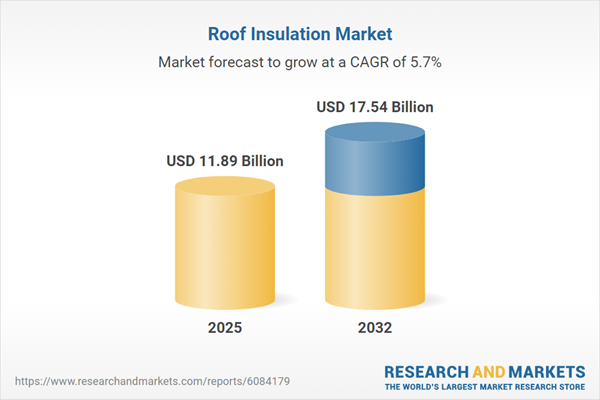Speak directly to the analyst to clarify any post sales queries you may have.
The roof insulation market is undergoing rapid transformation, shaped by converging demands for energy efficiency, evolving regulations, and investments in sustainable construction practices. Senior decision-makers face new imperatives to adapt product strategies, strengthen supply chains, and align with both performance and sustainability goals.
Market Snapshot: Global Roof Insulation Market Growth and Outlook
The global roof insulation market grew from USD 11.26 billion in 2024 to USD 11.89 billion in 2025. It is projected to expand at a CAGR of 5.70%, reaching USD 17.54 billion by 2032. Sustained momentum is powered by stricter building codes, spiking energy costs, and the push for reduced lifecycle carbon emissions. Senior leaders are increasingly focused on optimizing the building envelope as regulations tighten and stakeholder expectations escalate.
Scope & Segmentation: Detailed Coverage of the Roof Insulation Market
This report provides granular analysis of the market across five core segmentation dimensions. Each is critical to strategic planning for growth, compliance, and innovation.
- Technology: Blanket Insulation, Foam Board (Expanded Polystyrene Board, Extruded Polystyrene Board, Polyisocyanurate Board), Loose Fill Insulation (Cellulose, Fiberglass, Mineral Wool), and Spray Foam (Closed Cell, Open Cell).
- Material Type: Cellulose, Expanded Polystyrene, Extruded Polystyrene, Fiberglass, Mineral Wool, Spray Foam with Closed and Open Cell variants.
- End Use: Commercial (education, healthcare, retail), Industrial (data centers, manufacturing), Residential (single-family, multi-family housing).
- Distribution Channel: Direct Sales, Distributors/Wholesalers, Online Channels, Retailers.
- Application: New Construction, Retrofit.
Coverage extends across major geographic markets:
- Americas: North America (United States, Canada, Mexico); Latin America (Brazil, Argentina, Chile, Colombia, Peru).
- Europe, Middle East & Africa: UK, Germany, France, Russia, Italy, Spain, Netherlands, Sweden, Poland, Switzerland, UAE, Saudi Arabia, Qatar, Turkey, Israel, South Africa, Nigeria, Egypt, Kenya.
- Asia-Pacific: China, India, Japan, Australia, South Korea, Indonesia, Thailand, Malaysia, Singapore, Taiwan.
Leading market players analyzed:
- Kingspan Group plc
- Owens Corning
- Rockwool International A/S
- Compagnie de Saint-Gobain S.A.
- Johns Manville Corporation
- Knauf Insulation GmbH
- Armacell International S.A.
- BASF SE
- Dow Inc.
- Recticel N.V.
Key Takeaways: Strategic Insights for Decision-Makers
- Material innovation is accelerating, with advanced foam chemistries and bio-based alternatives reshaping both procurement and specification processes.
- Data-driven design and installation practices, including BIM and CFD simulations, are enhancing the precision and lifecycle value of insulation systems.
- Collaboration between manufacturers, specifiers, and contractors is evolving into a more integrated, results-driven approach, raising the bar for project outcomes and asset durability.
- Diverse regional priorities highlight varying adoption rates and performance benchmarks, from net-zero construction in northern Europe to large-scale retrofits in Asia-Pacific.
- Manufacturers are building resilience through near-shoring, strategic alliances, and flexible production lines capable of adapting to volatile feedstock markets.
Tariff Impact: Policy-Driven Supply Chain Dynamics
The introduction of new US tariffs on key insulation raw materials in 2025 disrupted traditional sourcing strategies. While short-term cost pressures challenged profit margins and project feasibility, many domestic producers responded by scaling capacity and considering near-shoring to reduce exposure to international trade risks. These changes catalyzed deeper interest in supply chain agility and vertical integration for future-proofing operations.
Methodology & Data Sources
This market analysis employs a rigorous mixed-method research design, integrating primary interviews across the value chain with in-depth reviews of technical documents, policy updates, and trade data. Data triangulation ensures robust, validated findings that reflect the latest industry realities.
Why This Report Matters: Decision Support for Senior Leaders
- Enables informed capital allocation and innovation investments by clarifying market drivers, constraints, and opportunities in key segments.
- Reduces risk by detailing regulatory trends, regional differentiation, and the impact of trade policies on supply chain stability.
- Supports competitive strategy development using up-to-date profiles of industry leaders and emerging market entrants.
Conclusion
The roof insulation market’s evolution reflects intensifying demands for sustainability, compliance, and operational resilience. Strategic action focused on innovation, supply chain optimization, and regional alignment will position industry leaders for sustained growth in this dynamic environment.
Table of Contents
3. Executive Summary
4. Market Overview
7. Cumulative Impact of Artificial Intelligence 2025
Companies Mentioned
The companies profiled in this Roof Insulation market report include:- Kingspan Group plc
- Owens Corning
- Rockwool International A/S
- Compagnie de Saint-Gobain S.A.
- Johns Manville Corporation
- Knauf Insulation GmbH
- Armacell International S.A.
- BASF SE
- Dow Inc.
- Recticel N.V.
Table Information
| Report Attribute | Details |
|---|---|
| No. of Pages | 185 |
| Published | October 2025 |
| Forecast Period | 2025 - 2032 |
| Estimated Market Value ( USD | $ 11.89 Billion |
| Forecasted Market Value ( USD | $ 17.54 Billion |
| Compound Annual Growth Rate | 5.7% |
| Regions Covered | Global |
| No. of Companies Mentioned | 11 |









